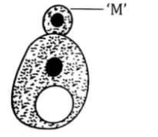EASY
Earn 100
Artificial parthenogenesis is a method of egg development without fertilization by sperm.
(a)True
(b)False
100% studentsanswered this correctly
Important Questions on Reproduction in Organisms
EASY
EASY
EASY
EASY
EASY
EASY
EASY
Identify the asexual reproductive structure in the following diagram:

MEDIUM
EASY
MEDIUM
Lateral branches arise from the basal and underground part of the main stem
Branches bent and grow downwards
Branches grow obliquely upwards
Lateral branches arise from the base of the main axis and are aerial
EASY
EASY
MEDIUM
EASY
EASY
EASY
Match the following
| List-I | List-II | ||
| (A) | Longitudinal binary fission | (I) | Paramoecium |
| (B) | Transverse binary fission | (II) | Amoeba |
| (C) | Sporogony | (III) | Pleurobrachia |
| (D) | Sporulation | (IV) | Plasmodium |
| (V) | Euglena |
MEDIUM
EASY

